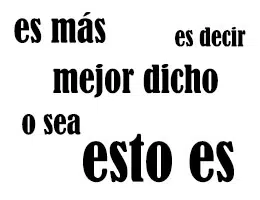 In the field of grammar, links are elements that enable the union of sentences, phrases and words . This link is achieved thanks to a syntactic function.
In the field of grammar, links are elements that enable the union of sentences, phrases and words . This link is achieved thanks to a syntactic function.
Explanatory links , in this framework, link statements that explain each other . By relating the two parts, more information is provided or what is intended to be communicated is better expressed.
For example : “Norberto is my mother's father, that is, my maternal grandfather.” As you can see, we have two fragments ( "Norberto is my mother's father" and "my maternal grandfather" ), joined by the explanatory link "that is." Saying that someone is “my mother's father” or “my maternal grandfather” is the same, although the variation of what is expressed helps to reinforce the idea .
In the example just presented we notice that the explanatory link allows us to join two propositions that are equally true if we convert them into individual sentences. Both have the same meaning , so the interlocutor does not need both to understand the main idea. Let's say that it helps us express an idea in two different ways or from two different points of view.
Let's look at another case: “I stopped working; Or rather, they fired me.” The sentence includes the explanatory link “rather” as a bridge between the parts “I stopped working” and “they fired me” . Although both statements are correct and basically allude to the same thing (the subject will no longer work in a certain place), the second part provides greater precision. This way it can be known that the person did not leave the job of his own free will, but rather was fired from it.
Here things change slightly: while in the example of the maternal grandfather the two propositions of the explanatory sentence had exactly the same meaning, the previous example presents us with two with different nuances. In this case, the use of the explanatory link better said helps us to correct our first preposition, to clarify our ideas so that the interlocutor understands the message more precisely.
 More sentences with an explanatory link: “These pants are not that new, in fact, they are several years old” (the explanatory link is “it's more” ), “The temperature does not exceed 10 degrees, that is, it is cold” (explanatory link : “that is to say” ), “The regime imposes strict censorship, that is, there is no freedom of expression” ( “this is” functions as an explanatory link).
More sentences with an explanatory link: “These pants are not that new, in fact, they are several years old” (the explanatory link is “it's more” ), “The temperature does not exceed 10 degrees, that is, it is cold” (explanatory link : “that is to say” ), “The regime imposes strict censorship, that is, there is no freedom of expression” ( “this is” functions as an explanatory link).
Thanks to the use of the explanatory link, we can even add information that complements the first proposition, unlike what usually happens with the previous ones, which rather present it from another point of view or correct it. It is worth mentioning that explanatory links are not always necessary for the interlocutor , but can arise from the insecurity of the sender himself if he believes that his message is not clear enough.
The need for explanatory links in communication occurs because human beings, or rather living beings, cannot avoid finding ourselves in a context , both social, historical and geographical, among others, and for this reason our words do not always they mean the same. Very often we must explain our statements, adding a certain amount of information that our recipient does not know beforehand.
Of course, this does not apply to certain "universal truths", such as the phenomena of physics, chemistry and mathematics, which in general we can express with short and precise sentences. Let's look at an example to contrast the exact sciences with an everyday situation. A chemist could tell us that "an ice cube melts if we subject it to a temperature equal to or greater than 100 degrees Celsius." However, in an informal conversation the verbs do not have the same weight: «the ice cream all melted; Well, rather it started to melt but it was still drinkable .
